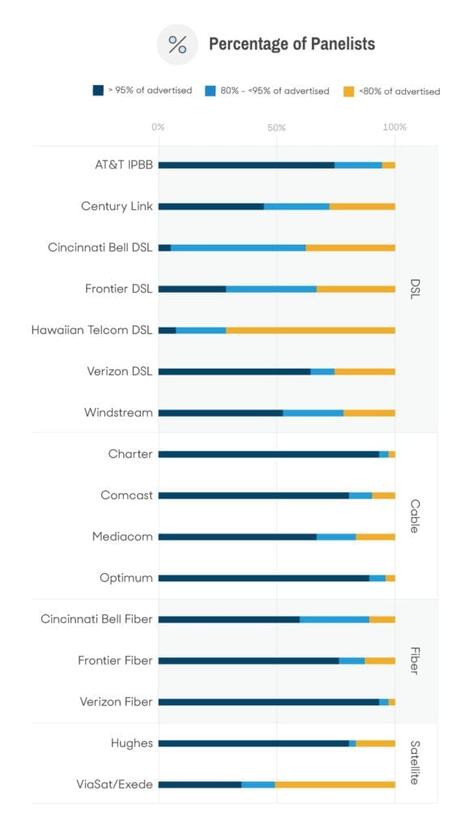Connecting to the internet has never been easier: Whether you’re chatting in coffee shops or setting up smart smoke detectors, there’s information uploading to the internet everywhere. But there are more options than ever, which can make it tricky to decide which technology is best for you. We’re going to walk you through all the major internet connection types and how you might choose your best.
A brief breakdown of your options
Each kind of internet connection is defined by its technology — how the connection is uploading and downloading internet information.
DSL: Short for “digital subscriber line,” DSL uses existing telephone wires to send data between your computer and the internet. Information is transmitted on a different frequency than voice calls. DSL is widely available and connects directly from the ISP to your home.
Cable: Data is transmitted via electricity through coaxial cables built out in neighborhoods for internet or cable TV. Widespread availability, except for more rural and secluded areas.
Satellite: Your computer sends information through your dish up to a satellite orbiting the planet, and that satellite communicates to network operations centers to acquire the data you requested.
Cellular: Mobile broadband that lets you connect to the internet wireless anywhere via cell phone towers, using your mobile device or hot-spotting to other devices.
Fiber-optic: Similar to cable, but it uses small strands of glass to transmit the information as light. Minimal availability and costly to build out — mostly accessible in large cities.
“Fiber’s growth potential is theoretically limitless, which no other physical medium can claim…In an ideal world, all internet connections would be fiber.” – Trevor Textor, Project Manager, Rural IT & Connectivity Consultant.
Speed is a defining factor
For consumers, the most obvious difference between these connection types will be speed. Each technology offers a different range of connection speeds, which will affect the time it takes to upload, download, stream, and browse.
DSL is typically the slowest internet, offering customers choices between 1.5Mbps, 3Mbps, 5Mbps, 7Mbps, 12Mbps, 24Mbps, and (rarely) 40Mbps. Considering the FCC reported that the median household internet speed is 72Mbps, DSL options cater to the minority of light internet users. These speeds will be enough to do some simple web browsing and sending emails — if you have a few people streaming video at once, you will experience loading issues.
With satellite internet, you won’t have speed options when purchasing. You’ll choose a package based on data usage instead. The satellite technology is limited to just one speed: 25Mbps with HughesNet and 12Mbps with Viasat. For smaller households and moderate internet use, this may be a fine option.
Cable internet is likely the best option for most people. It’s the most versatile internet connection type, offering speeds from 10Mbps to 200Mbps and beyond. And cable internet providers usually offer the option to bundle with other services like TV too.
Fiber is the fastest internet connection available right now and works similarly to cable. If you’re one of the lucky few who have access to fiber-optic internet, you can find speeds as fast as 1000 Mbps. Paired with its higher-quality connection, fiber-optic is best for households that consistently have multiple people streaming video, playing games, working from home, or downloading files.
Cellular internet connections are typically just for mobile use, and 4G LTE is the fastest available at the time. It translates to about 50+ Mbps at peak speed but can be as slow as 5Mbps.
The next iteration of this technology, 5G, could replace your home internet with speeds as fast as fiber.
Reliability is important too
Just because an internet provider advertises certain speeds doesn’t mean it guarantees those speeds. There are a lot of factors that can influence the connection strength — high-traffic times in your neighborhood, weather, router type, etc. If an internet connection isn’t particularly reliable, you won’t consistently get the speeds you pay for.
The FCC found DSL internet was the least reliable at delivering advertised speeds to its customers, with less than 10% of Cincinnati Bell and Hawaiian Telcom customers getting advertised speeds (although other DSL providers, like Verizon and AT&T, showed more consistent performance). However, around 80% of cable and fiber-optic internet customers received 95% or more of advertised speeds, with Charter (Spectrum) cable and Verizon fiber showing the best reliability.

What’s best for you?
Your first step is to look at the providers in your area and discover if they serve your address. Your options may be limited — building out service lines is expensive, and providers tend to avoid building where other providers are already offering service. You can ask neighbors who they get their internet from or simply plug your address in online to start your search.
Satellite internet options, like HughesNet, will be available to almost everybody.
If you happen to have a few options, you’ll want to compare their plans. To know which plan fits you best, assess your speed needs. You’ll need to consider the number of people using the internet in your household, the number of devices connecting (everything from your computer to your smart hub), and survey your household’s typical internet activity (streaming is more demanding than emailing, for example).
After years of internet research and consulting network experts, we’ve built a guide to help you gauge the internet speed that will best fit your household. Determine where you are on the range of light use to very heavy use, then match that to the number of connected devices in your home.
Light UseModerate UseHeavy UseVery Heavy Use1-3 devices5-10 Mbps15 Mbps25 Mbps50 Mbps4-8 devices15 Mbps25 Mbps50 Mbps100 Mbps8-10 devices25 Mbps50 Mbps100 Mbps150 Mbps10+ devices50 Mbps100 Mbps150 Mbps200+ Mbps
From there, you should compare price, fees, and overall value. If you have more questions, check out our detailed guide to internet providers.


